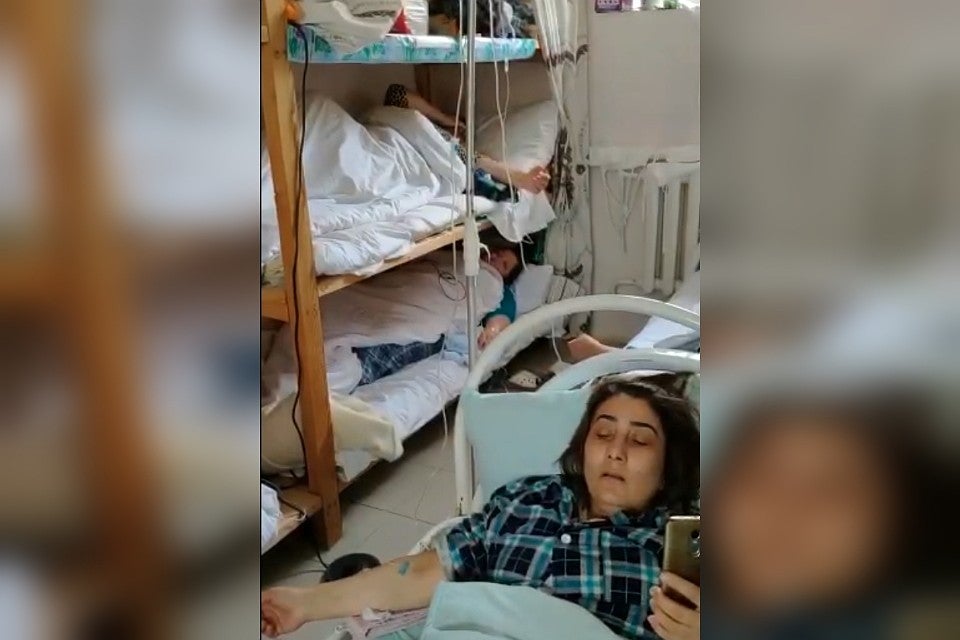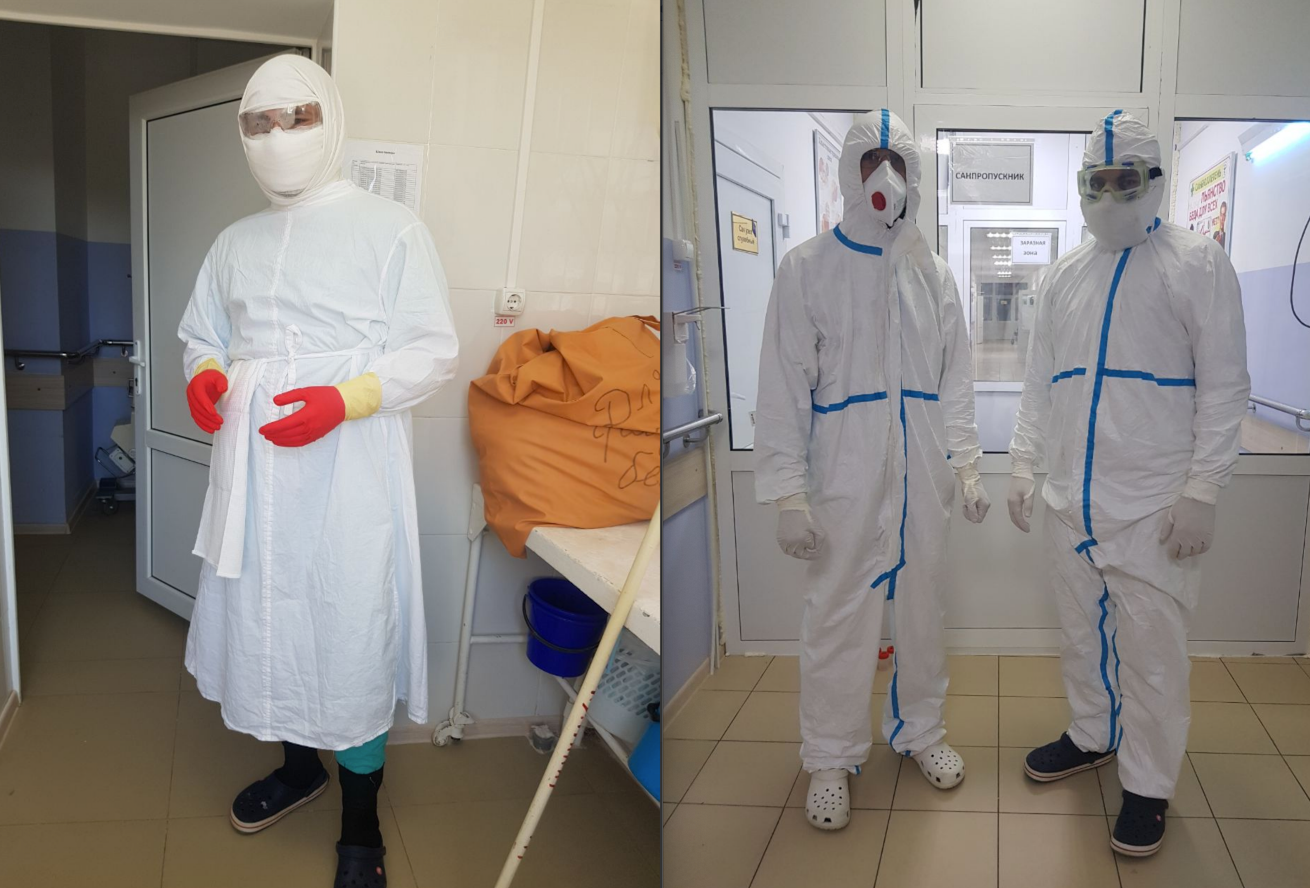Inside Russia’s secret pandemic: How Dagestan ignored ‘hundreds’ of coronavirus deaths
‘We were panicked by the reports from Italy. Then Italy came to us,’ says a paramedic who risked the state’s wrath by speaking out. Oliver Carroll reports from Moscow


Ibragim Yevtemirov saw the corpses with his own eyes. At the start, they died in twos and threes. Then there were five or six a day. At the peak, 13 bodies passed through the hospital daily.
The surgeon says doctors could see catastrophe closing in on them like a “violent and thunderous wall”. But locals in Khasavyurt, Dagestan’s main market town near the border with Chechnya, wrote the virus off as a Masonic conspiracy. They didn’t trust the federal government – there was history here – and by extension the doctors. They continued to meet, to embrace each other, and, invariably, to wind up in hospital.
With the first deaths, came the mass funerals. Hundreds more would fall ill. It was “like watching climbers falling from mountains, dragging one another down, one by one,” says Yevtemirov. Soon, Khasavyurt was sealed off by the police, with helicopters piercing the cordon to evacuate the worst cases daily. “We hadn’t seen helicopters since the Chechen wars... and it felt like a war, with the hospital in the middle of a protracted siege and bodies falling around us.”
The horrors Yevtemirov and his colleagues witnessed – alongside the absence of corresponding acknowledgement in official statistics – reinforce doubts over the Kremlin’s official Covid-19 narrative. Up until a few days ago, authorities were insisting just a couple of dozen people had died in the mostly Islamic republic on Russia’s southern border. Even now, the official figure is 29. But locals understood the figures bore little relation to reality. From late April, reports began to emerge suggesting hundreds were dying every week from Covid-19-related pneumonia in the republic.
Initially, local authorities shielded statistics on pneumonia incidence and bed occupancy. But on Sunday, Dagestan’s health minister Djamaludin Gadzhiibragimov made some of the shocking figures public. Nearly 700 people had died from pneumonia, he admitted, and in the absence of a clear Covid-19 diagnosis, none had been included in the official statistics. A further 7,000 people were in hospital receiving treatment, the minister added.
Perhaps the most appalling admission of all was that at least 40 medics had died during the epidemic. In other words, more doctors and nurses had died than the claimed total number of fatalities. Yevtemirov’s crisis-ridden hospital in Khasavyurt was responsible for at least seven of those deaths. “Just this Sunday, another nurse from the clinic died,” the surgeon says. “She was my neighbour as well.”
The low accuracy of Covid-19 testing in Russia, which seems to be fuelling the underreporting of fatalities, has already been extensively reported. Anecdotally, the local-made nucleic acid tests, designed to detect active virus, pick up no more than 20 per cent of infections. In Dagestan, the problem is probably exacerbated by poor training and sampling techniques. In Khasavyurt, for example, doctors were for a long time using commercially available cotton buds. Not only unsterilised, they were also far too short to obtain an accurate nasopharyngeal swab.
“We don’t get a choice in the matter,” says Yevtemirov. All the tests are sent away, the doctor explains, and only if they come back positive is coronavirus mentioned on the death certificates. “If not, then it’s put down as community-acquired pneumonia, though nobody here is in any doubt it’s Covid-19.”

Dagestan’s medical community is not activist by nature. In more normal times, doctors and nurses kept their heads down, navigating as best they could corruption, decaying infrastructure and monthly salaries of a few hundred pounds. But the perfect storm of the last two months has encouraged many to speak out.
On 20 April, paramedic Sakinat Magomedova risked her bosses’ fury by participating in a video appeal for respirator masks and hazmat suits. In the early weeks of the pandemic, local medics were left without any protective equipment to speak of. Hospitals sourced PPE as they could find it: washing up gloves and wellington boots from the local market; masks from the building trade. But ambulance crews like hers in Kizilyurt had absolutely nothing. So following two 24-hour shifts in a row, a tired and exasperated Magomedova put her face to the appeal.
“All throughout March we were panicked by what we saw in Italy, but then we saw how Italy came to us,” she tells The Independent. “I had no choice but to speak out. Colleagues were dying. Hospitals were so full you couldn’t hospitalise anyone. Even the medicines had run out — you could only get antibiotics if you knew someone.”
A week after recording the video, Magomedova herself came down with the classic case of Covid-19: weakness, pain, and pneumonia in both lungs. She would spend the next three weeks off work in self-isolation. But there was never any question of getting a test. “I was too ill, and I knew how unreliable they were anyway,” she says. Were local authorities using that fact to cover up the real state of affairs? “Quite possibly. They must have known the situation was a lot worse than they were saying.”
Ziyutdin Uvaisov, an activist who has raised money to reverse the shortages of PPE in the region, accuses the local authorities of “double standards”. On the one hand, they asked all doctors to assume pneumonia as Covid-19 and treat it accordingly, he says. On the other hand, they refused to count them in official statistics. They were also failing the basic test of keeping doctors safe: “The bureaucrats want to keep the problem secret. Our view is that there is no point hiding rubbish under the carpet.”
Starting in early April, Uvaisov’s “Patient Monitor” NGO raised more than 500,000 roubles (£5,600) from businessmen and other private individuals. The organisation was inundated with hundreds of requests from desperate medics and it did what it could to cover the shortfalls of masks, respirators, gowns, glasses, and hazmat suits. The requests are coming in less frequently now, Uvaisov says — offering hope, perhaps, that a corner has been turned.
Another encouraging sign is that Moscow is beginning to acknowledge the true scale of the problem. On Monday, following the weekend’s admission of hundreds of unexplained deaths, Vladimir Putin said he would personally be monitoring the situation. He praised the “self-sacrificing efforts” of doctors and nurses, and demanded more testing capacity be made available in the region. A few hours later, Moscow’s defence ministry announced it would be building an emergency 200-bed field hospital in Dagestan to cope with the demand.
But as far as blame was concerned, the Russian president seemed to lump that on the dead Dagestanis themselves. Those who died were seen too late or developed problems after self-medicating, he said.
Uvaisov says many Dagestanis were shocked by the comments.
“The president suggested people sought medical assistance too late, or self-medicated,” he says. “I’d like him to explain how they were supposed to get help when the hospitals were full, or self-medicate when the chemists had run out of medicine.”
Join our commenting forum
Join thought-provoking conversations, follow other Independent readers and see their replies
Comments